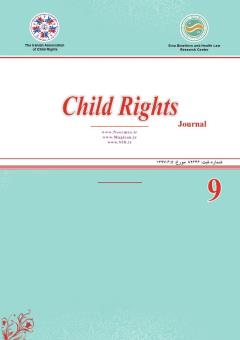The Rights of Children with Disabilities in Iran: An Analysis of Determining Areas
Subject Areas : حقوق کودک
1 - Faculty of Social Sciences, Tehran University, Tehran, Iran
Keywords: Children with Disabilities, Children's Rights, Laws and Regulations, the Islamic World, the International Community,
Abstract :
Background and Aim: The present study seeks to identify, interpret and analyze the rights of children with disabilities in Iran. In this regard, the decisive fields of jurisprudence and law have been identified and analyzed at the domestic and international level. Method: The research approach is qualitative and the research method is exploratory and documentary analysis. After identifying the documents related to the subject and issue of the research, they have been studied, analyzed and reviewed. Results: The results of the research show that at the international level and the Islamic Covenant on the Rights of the Child and in the internal laws and regulations of the Iranian society, the society and the political power structure are responsible for formulating and implementing protective policies for disabled children and these policies are also aimed at reducing harm, rehabilitating and Treatment of the disabled. In fact, they are considered a "posteriori strategy" towards the disabled. But in the religion of Islam, centered on Shiism as the dominant religion in Iran, dealing with the child is about potentially being a child, not actually being a child; This means that the children of future generations are considered and "foreseeable" in the current generation. It is as if the scope of childhood includes history and generations and is a "transhistorical" and “trans-generational" issue. Islam has emphasized on the "future and posterity" and respecting the potential rights of the next generations and has a "preventive" approach. Conclusion: The dominant strategy of the teachings of Islam in relation to children with disabilities can be inferred as "a priori and a posteriori strategy". In addition to the governing authority, community activists are responsible for the realization of plans related to this strategy for disabled children.
1. Sha’ban M, Mohseni Tabrizi AR, Ja’fari F. Sociological Analysis of the Rights of Children with Disabilities: Policies of Iran, the Islamic World, and the International. International Journal of Social Sciences. 2020; 10(2): 35-44.
2. Shaban M. Sociology of Childhood in Iran: Emergence and Transformation. PhD Thesis. Tehran: Faculty of Social Sciences, University of Tehran; 2020. [Persian]
3. Robinson Nani M, Robinson Halbert B. Mentally Retarded Child. Translated by Maher F. Mashhad: Astan Quds Razavi Publishing; 1991. [Persian]
4. World Health Organization. Effects and consequences of diseases, UNESCO; 1996.
5. Mohseni Bandpey A. 30,000 disabled children are born in the country annually. ISNA News Agency, May 7, 2017, news code 96021811144. [Persian]
6. Koozegar MA., Welfare support for five million people, we have 25,000 children with disabilities annually. Mehr News Agency, September 1, 2016, news code 4390635. [Persian]
7. Rezaei A, Elsan M. Educational rights of children with disabilities in Iran: The need to keep pace with international developments. Journal of Legal Research. 2008; 7(13): 221-236. [Persian]
8. Kamali M, Iran F. A Review of the Rights of Children with Disabilities. Journal of Social Welfare. 2003; 2(7): 93-110. [Persian]
9. Razavizadeh M. How many children are disabled in Iran?. Report Journal. 2008; 17(202): 35. [Persian]
10. Eide AH, Braathen SH. Disability and equity in global health. Tidsskrift for den norske legeforening. 2017.
11. Convention on the Rights of Persons with Disabilities. New York; 2006.
12. Hodgkin R, Newell P. Implemenation Handbook for the Convention on the Rights of the Child Gereva. Switzer Land: Unicef; 1998. p.19.
13. UN Committee on the Rights of the Child (CRC), General comment No.9 (2006). The rights of children with disabilities; 2007, CRC/C/GC/9. Available at: https://www.refworld.org/docid/461b93f72.html. Accessed May 23, 2021.
14. Convention on the Rights of the Child. Adopted and opened for signature. 1959.
15. LeBlanc LJ. The Convention on the Rights of the Child. Leiden Journal of International Law. 1991; 4(2): 281-291.
16. Artida T, Taghizadeh M. Rights of Children and Adolescents in the Islamic Republic of Iran: Collection of Laws and Regulations until the End of 2009. 1st ed. Tehran: UNICEF Publishing; 2012.
17. Ebadi SH. Comparative Child Rights. 1st ed. Tehran: Kanoon Publishing; 1997. [Persian]
18. Ebadi SH. Children's rights: A look at children's legal issues in Iran. 4th ed. Tehran: Kanoon Publishing; 1996. [Persian]
19. Meikhabar S. Reyhaneh Beheshti; Farzande Saleh. Qom: Noor al-Zahra Publishing; 2020. [Persian]
20. Fowzi Tuyserkani Y. Organization of the Islamic Conference. Tehran: Ministry of Foreign Affairs; 1998. [Persian]


